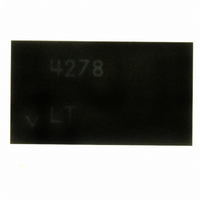LTC4278CDKD#PBF Linear Technology, LTC4278CDKD#PBF Datasheet - Page 34

LTC4278CDKD#PBF
Manufacturer Part Number
LTC4278CDKD#PBF
Description
IC PD IEEE 802.3AT 25.5W 32-DFN
Manufacturer
Linear Technology
Datasheet
1.LTC4278CDKDPBF.pdf
(40 pages)
Specifications of LTC4278CDKD#PBF
Controller Type
Powered Device Interface Controller (PD)
Interface
IEEE 802.3af
Voltage - Supply
4.5 V ~ 20 V
Current - Supply
6.4mA
Operating Temperature
0°C ~ 70°C
Mounting Type
Surface Mount
Package / Case
32-DFN
Input Voltage
60V
Supply Current
1.35mA
Digital Ic Case Style
DFN
No. Of Pins
32
Duty Cycle (%)
88%
Frequency
100kHz
Operating Temperature Range
°C To +70°C
Msl
MSL 1 - Unlimited
Rohs Compliant
Yes
Lead Free Status / RoHS Status
Lead free / RoHS Compliant
Available stocks
Company
Part Number
Manufacturer
Quantity
Price
APPLICATIONS INFORMATION
LTC4278
Output Voltage Error Sources
The LTC4278’s feedback sensing introduces additional
minor sources of errors. The following is a summary list:
• The internal bandgap voltage reference sets the reference
• The external feedback resistive divider ratio directly
• Leakage inductance on the transformer secondary
• The transformer secondary current fl ows through the
If the output load current is relatively constant, the feedback
resistive divider is used to compensate for these losses.
Otherwise, use the LTC4278 load compensation circuitry
(see Load Compensation). If multiple output windings are
used, the fl yback winding will have a signal that represents
an amalgamation of all these windings impedances. Take
care that you examine worst-case loading conditions when
tweaking the voltages.
Power MOSFET Selection
The power MOSFETs are selected primarily on the criteria of
on-resistance R
breakdown voltage (BV
and maximum drain current (ID
For the primary-side power MOSFET, the peak current is:
where X
earlier.
34
voltage for the feedback amplifi er. The specifi cations
detail its variation.
affects regulated voltage. Use 1% components.
reduces the effective secondary-to-feedback winding
turns ratio (NS/NF) from its ideal value. This increases
the output voltage target by a similar percentage. Since
secondary leakage inductance is constant from part to
part (within a tolerance) adjust the feedback resistor
ratio to compensate.
impedances of the winding resistance, synchronous
MOSFET R
equivalent current for these errors is higher than the
load current because conduction occurs only during
the converter’s off-time. So, divide the load current by
(1 – DC).
I
PK(PRI)
MIN
=
V
is peak-to-peak current ratio as defi ned
DS(ON)
IN(MIN)
DS(ON)
P
IN
and output capacitor ESR. The DC
• DC
, input capacitance, drain-to-source
DSS
MAX
), maximum gate voltage (V
• 1+
(MAX)
X
).
MIN
2
GS
)
For each secondary-side power MOSFET, the peak cur-
rent is:
Select a primary-side power MOSFET with a BVDSS
greater than:
where NSP refl ects the turns ratio of that secondary-to
primary winding. LLKG is the primary-side leakage induc-
tance and CP is the primary-side capacitance (mostly from
the drain capacitance (COSS) of the primary-side power
MOSFET). A clamp may be added to reduce the leakage
inductance as discussed.
For each secondary-side power MOSFET, the BV
be greater than:
Choose the primary-side MOSFET R
gate drive voltage (7.5V). The secondary-side MOSFET gate
drive voltage depends on the gate drive method.
Primary-side power MOSFET RMS current is given by:
For each secondary-side power MOSFET RMS current is
given by:
Calculate MOSFET power dissipation next. Because the
primary-side power MOSFET operates at high V
transition power loss term is included for accuracy. C
is the most critical parameter in determining the transition
loss, but is not directly specifi ed on the data sheets.
BV
I
I
I
BV
PK(SEC)
RMS PRI
RMS SEC
DSS
DSS
(
(
≥ V
≥
)
=
I
)
PK
=
=
OUT
1 DC
V
IN MIN
I
OUT
L
− 1
+ V
(
C
LKG
I
MAX
P
OUT
DC
IN(MAX)
P
)
+
IN
MAX
• 1+
DC
V
IN MAX
MAX
(
• N
X
MIN
SP
2
)
+
V
DS(ON)
OUT MAX
N
SP
(
at the nominal
)
DSS
should
MILLER
DS
4278fa
, a













